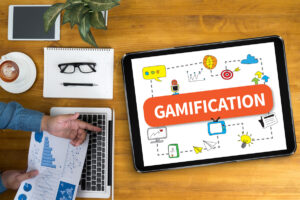Gamification has grown exponentially in the past decade. Today, many organisations are embracing the use of Gamification not only to market their products, but also to recruit and train staff. So just what is Gamification?
What is Gamification?
Essentially, Gamification is the use of strategic game designs and mechanics to motivate the interested parties to achieve their objectives (in HR’s case, that’s candidates and employees). It comes down to using game principles and techniques in a non-game context (i.e. work-related scenarios). Interestingly, it’s becoming increasingly popular and is more widely used than ever.
Gamification in HR
Improve Talent Acquisition and Management
Today, the traditional recruitment process is getting replaced by a digitally supported alternative that speeds up the process as well as helping to evaluate the future job performance of the applicant. At ProgressionHR, we’ve learnt that Gamification is often being used to grab the attention of candidates and raise interest in job openings.
We’ve also discovered you can easily turn the hiring process into a gamified experience by rewarding prospects with both acknowledgment and tangible perks for completing each step, from application to start date. You’ll find providing incentives can not only help attract qualified candidates from the start, but can also dramatically increase onboarding efficiency as candidates are motivated to complete various steps to earn rewards. Importantly for recruitment, along the way users are motivated to stay engaged in the recruitment process.
Cultivating corporate culture and retaining valued employees
Keeping employees engaged and feeling like they’re part of the team is critical for retention. We all know retention is key in maintaining valuable key people, institutional knowledge and consistency and avoiding costly turnover. The good news is, you can use Gamification to promote a positive corporate culture by rewarding employees for cross-departmental collaboration, providing a process or product improvement suggestions or even participating in company-wide volunteer programmes.
Tracking activity easily
You can use a gamified platform to track activities and opportunities, as well as showcase employee participation to their co-workers to provide intrinsic motivation. As an added benefit, a gamified platform maintains a record of all employee activities in the programme, which is extremely valuable information when it comes time to consider promotions, salary increases and other rewards.
We’ve found that while it’s easy for businesses to see how they might use Gamification in sales to motivate performance (or even in customer support) to incentivise quick, satisfactory resolutions, the Human Resources function of any business can also leverage Gamification techniques to incentivise and reward employees for completing important (but possibly mundane) tasks when they really don’t want to.
Motivate employees to learn and participate in training
Mandatory HR training (covering topics like harassment, diversity and other compliance programmes) is often not high on employees’ priority lists, especially when they don’t see a relationship with this to their day-to-day job duties. Motivating them to take time out of their busy day to complete such programmes in a specified time period can be challenging. But research shows adding a Gamification experience to online learning can spur action. Employees who earn rewards and recognition for having completed such tasks in the Gamification lexicon are far more likely to make it a priority. Moreover, HR benefits from the ability to check those boxes for compliance in a timely fashion without the pressure of having to hound employees to complete the programmes.
Incentivise Paperwork and Other Administrative Requirements
Not many of us like to complete paperwork, especially when other tasks are more pressing or exciting. But we also know paperwork is unavoidable. So why not make it fun? Similar to training applications, rewarding employees with either peer or management recognition (or even tangible incentives) for completing required forms can create a friendly competition. You can have employees try to out-do one another for the title of “Best Expense Reporter” or “Quickest To Complete Benefits Update Forms”.
Gamification in mapping an employee’s path to career success
We all know peer mentorship is a powerful motivator that drives employees to want to succeed. By using Gamification, HR can create transparent, mission-based career paths that show the steps employees have taken to step up in the organisation. For example, perhaps the top salesperson completes refresher training annually, turns in expense reports within a week of travel, keeps his/her prospect pipeline up to date, logs 5 new leads every week and follows up on two.
By showcasing this behaviour in a gamified platform, other employees can see what it takes to become the top salesperson as this mentor provides a bread-crumb path to show peers the way to the top.
Are you ready to harness the power of Gamification?
Staying up to date on all the latest HR trends can help HR teams to maintain efficient and user friendly solutions. Today, that includes Gamification.
If you’re ready to adopt HR Gamification in your organisation, we’re certain it will help make the work of the employees a whole lot more enjoyable, creative and efficient. The question is, if you haven’t already, how will you harness Gamification in your organisation?
3 Great Case Studies Of Gamification
How does gamification work?
My Marriott Hotel is a game that has been developed by Marriott International to recruit newbies. It allows the candidates to run their own virtual hotel in which they design their own restaurant, purchase inventory, train employees and serve guests
Cisco uses Gamification in very different programmes. For example, they started using Gamification principles in their social media training to build this skillset for their employees.
Deloitte digitalised and gamified their onboarding process. New employees form teams with other starters and learn about privacy, compliance, ethics and procedures online. They can launch pre-set questions into their team that everyone has to answer.






